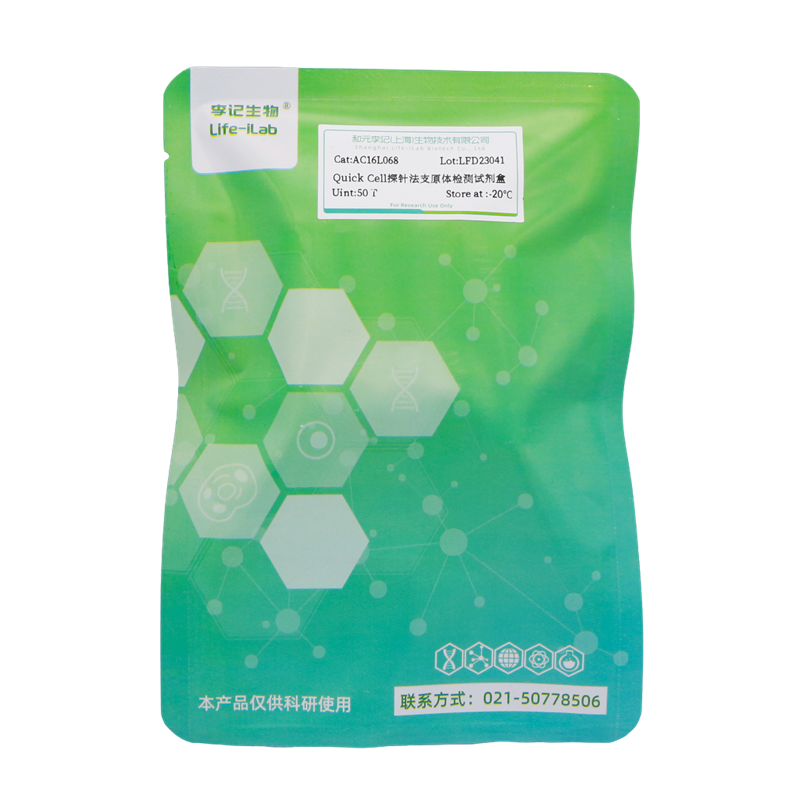Product Description
The Quick Cell qPCR Mycoplasma Detection Kit with Probe uses Mycoplasma specific primers and Mycoplasma specific fluorescent probes (reporting gene FAM) for fluorescence quantitative PCR amplification detection of Mycoplasma genomic DNA in samples. The reagent kit contains both the reference plasmid mycoIC2 and corresponding primers and fluorescent probes (reporting gene VIC) for monitoring the efficiency of Mycoplasma DNA extraction and qPCR amplification. This kit can be used to detect any sample that may contain Mycoplasma, such as in vitro cell culture supernatants, serum, various body fluids (such as saliva, urine, nasal secretions), and other liquid samples.
After multiple tests, this kit has records of identifying 20 types of mycoplasma that have been reported in vitro cell culture. According to literature reports, these mycoplasma species account for almost 100% of the mycoplasma species that contaminate cells. Specifically, (1) M hyorhinis、 (2)M. fermentans、 (3)M. arginini、 (4)M. hominis、 (5)M. orale、 (6)M. salivarium、 (7) M. Pirum, (8) A laidlawii、 (9)M. agalactiae、 (10)M. bovis、 (11) M. bovoculi, (12) A axanthum、 (13)M. buccale、 (14) M. pneumoniae, (15) M arthritidis、 (16)M. pulmonis、 (17)M. gallisepticum、 (18)M. gallinarum、 (19)M. canis、 (20) Ureaplasma urealyticum (M. stands for Mycoplasma; A. stands for Acholeplasma).
Product components
Product components | Specifications |
Probe method solution 1P (50T) | 550 μ L, containing primers and fluorescent probes for mycoplasma and internal reference detection |
Probe method solution 2T (50T) | 50 μ L, enzyme solution |
Internal reference plasmid mycoIC2 | 500 μL |
Deionized water | 1.2 mL |
Positive Mycoplasma DNA | 50 μL |
Note: ① Due to the presence of the internal reference plasmid mycoIC2 (used to monitor the effectiveness of Mycoplasma DNA extraction and qPCR amplification) in this kit, customers can choose to extract the sample Mycoplasma DNA (the internal reference plasmid mycoIC2 is added during the Mycoplasma DNA extraction process), or choose not to extract the sample Mycoplasma DNA (the internal reference plasmid mycoIC2 is added during system preparation).
② The supporting instrument of this kit can be any fluorescence quantitative PCR instrument with FAM and VIC detection channels.
Transportation and storage
Blue ice transportation- Store at 20 ℃ away from light, with a shelf life of 60 months.
matters needing attention
1. This product is mainly used for detecting mycoplasma contamination in cell supernatant and is only for scientific experimental research. It should not be used in clinical diagnosis, treatment, and other fields.
2. Precautions for preventing DNA contamination:
(1) It is strongly recommended to use filter tips for all operations (especially during qPCR system preparation steps and when extracting reagents from the kit) to avoid contamination of the reagents.
(2) It is necessary to ensure that the pipette used does not have any residual mycoplasma.
(3) All types of probes and centrifuge tubes used for sample pre-treatment, as well as probes used to extract positive control DNA and test sample DNA, must be handled with care. Please place them in a capped, sealable bottle containing half a bottle of water. After all samples are extracted, cover the bottle cap to prevent the volatilization of positive DNA, which can cause environmental pollution and false positives. It is best not to speak during the entire operation process, as the human mouth and saliva are contaminated with mycoplasma.
(4) After the reaction, do not open the lid of the reaction tube, otherwise it may cause contamination of the testing environment. After the result is judged, seal it with a self sealing bag and handle it appropriately.
3. The laboratory must strictly operate in separate rooms (it is recommended to operate this reagent kit in a regular room with windows and good ventilation, and not in a closed room. Do not perform this step in the cell culture room, as the probability of mycoplasma contamination in the cell culture room is high):
Reagent Preparation Room 1: Specially designed for the preparation of quantitative PCR systems (it is recommended that all imported filter tips be used in this room)
DNA extraction room 2: dedicated to extracting mycoplasma DNA;
DNA Sample Room 3: After preparing a quantitative PCR system, perform operations such as adding test samples, positive controls, negative controls, etc;
PCR amplification room 4: Perform real-time fluorescent PCR amplification detection.
Note: If the room is tight, consider merging Room 2 and Room 3 into one room, while Room 1 and Room 4 must be independent. All items in each room (including pipettes) are for exclusive use and cannot be used interchangeably.
4. If the amplification of qPCR is inhibited by the metabolic products of cells (qPCR results: no amplification curve for mycoplasma channel and internal reference control channel), the following measures can be taken:
(1) Advance the sampling time to 2 or 3 days after fluid change, at which point the PCR amplification inhibitors in the cell supernatant are relatively low and generally do not produce severe inhibition. According to our testing, after 5 days of changing the solution, PCR amplification inhibitors had already accumulated significantly.
(2) Wash the test sample by centrifugation with PBS to remove inhibitors from the sample. The specific method is as follows: Take 1 mL of cell supernatant, centrifuge at 13000 rpm for 10 minutes, and aspirate 950 μ L of supernatant; Add 950 μ L of PBS, centrifuge again, and aspirate 950 μ L of supernatant; Add 950 μ L of PBS, centrifuge for the third time, carefully aspirate all the supernatant (to avoid touching the bottom precipitate, 3-5 μ L of the bottom liquid can be retained), resuspend the precipitate in 50 μ L of 5 mM Tris HCl at pH 8.0-8.8, heat at 95 ° C for 5 minutes, centrifuge briefly (1000 g, 5 seconds), and take the supernatant for detection. However, this method has the following drawbacks: firstly, if the sample has a low content of mycoplasma, centrifugal cleaning may lead to missed detection, as the process of centrifugal cleaning may result in partial loss of mycoplasma. Secondly, some samples cannot completely remove inhibitors even after the above-mentioned cleaning.
(3) Extract mycoplasma DNA from the cell supernatant and perform PCR identification.
(4) The Quick Cell Mycoplasma Rapid Detection Kit (cell culture specific) (item number: AC16L061) or Quick Cell Luminescence Mycoplasma Detection Kit (item number: AC16L062) from Li Ji Biology was used for testing. After testing, it was found that these two kits were not inhibited by the metabolic products of cells. To prevent the problem of PCR amplification being inhibited by cellular metabolites, it is also possible to consider centrifuging and washing all test samples or extracting DNA before using this kit for detection.
5. Mycoplasma detection samples can be divided into two categories: the first category is the supernatant of mammalian cells cultured in serum containing culture medium, which is very suitable for the growth of Mycoplasma. After several days of cultivation, the density of Mycoplasma is generally high, reaching 107-9/mL, and can be directly detected. The second type includes samples such as plasma, serum, umbilical cord blood, pancreatic enzymes, antibiotics, unused culture media, etc. that are stored at low temperatures. Even if these samples are contaminated with mycoplasma, the mycoplasma content is generally very low. Therefore, direct use of rapid mycoplasma detection kits for detection often fails to detect mycoplasma. These sample suggestions: (1) Centrifuge and concentrate the mycoplasma in the sample to extract mycoplasma DNA. These two methods can further increase the detection sensitivity by approximately 10-100 times. This method is fast and produces results on the same day, but its reliability is not as good as the later cultivation method. (2) Cultivate with Mycoplasma liquid culture medium (both non arginine and arginine containing Mycoplasma liquid culture media must be inoculated simultaneously) for 3-7 days before testing. Please refer to the last section of the instructions for the Li Ji Bio Quick Cell Luminescence Mycoplasma Detection Kit (item number: AC16L062) for specific methods. This method is slow and takes 3-7 days, but it has high reliability.
6. How to improve the detection sensitivity of this reagent kit: If the expected mycoplasma content in the test sample is low (such as serum, umbilical cord blood, trypsin, antibiotics, unused culture medium, biological products, and a few cell culture supernatants), the following measures can be taken: (1) Concentrate and extract mycoplasma DNA before testing (the extraction process can also remove all possible PCR inhibitors), which can increase the detection sensitivity by about 10-100 times. (2) Centrifuge and concentrate Mycoplasma: Take 1 mL of cell supernatant, centrifuge at 13000 rpm (approximately 16000 g) for 10 minutes, remove all supernatant, resuspend the precipitate in 50 μ L of 5 mM Tris HCl at pH 8.0-8.8, heat at 95 ℃ for 5 minutes, centrifuge briefly (1000 g, 5 sec), and take the supernatant for detection. The centrifugal concentration process can increase the detection sensitivity by approximately 20 times. (3) If the sample is not extracted, the detection sensitivity can be increased by 9 times by increasing the amount of DNA added to the reaction tube, such as from 2 μ L to 18 μ L. (For test samples that have not been extracted, purified, or centrifuged, the volume of the test sample cannot be directly expanded, otherwise the possibility of PCR inhibition will increase significantly.)
7. If cells are found to be contaminated with mycoplasma, it is recommended to use Li Ji Biology's Quick Cell Mycoplasma Removal and Prevention Kit (item number: AC16L066), EZ Water Bath Antibacterial Agent (item number: AC16L162), and EZ Cell Room Antibacterial Agent (item number: AC16L143). For product details, please consult with sales personnel or visit the official website: life-ilab.com
This product is only for scientific experimental research and should not be used in clinical diagnosis, treatment, or other fields.














 Back
Back
 Back
Back




























